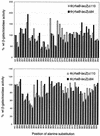Roles of cyclic AMP receptor protein and the carboxyl-terminal domain of the alpha subunit in transcription activation of the Escherichia coli rhaBAD operon
- PMID: 10852886
- PMCID: PMC101950
- DOI: 10.1128/JB.182.12.3529-3535.2000
Roles of cyclic AMP receptor protein and the carboxyl-terminal domain of the alpha subunit in transcription activation of the Escherichia coli rhaBAD operon
Abstract
The Escherichia coli rhaBAD operon encodes the enzymes for catabolism of the sugar L-rhamnose. Full rhaBAD activation requires the AraC family activator RhaS (bound to a site that overlaps the -35 region of the promoter) and the cyclic AMP receptor protein (CRP; bound immediately upstream of RhaS at -92.5). We tested alanine substitutions in activating regions (AR) 1 and 2 of CRP for their effect on rhaBAD activation. Some, but not all, of the substitutions in both AR1 and AR2 resulted in approximately twofold defects in expression from rhaBAD promoter fusions. We also expressed a derivative of the alpha subunit of RNA polymerase deleted for the entire C-terminal domain (alpha-Delta235) and assayed expression from rhaBAD promoter fusions. The greatest defect (54-fold) occurred at a truncated promoter where RhaS was the only activator, while the defect at the full-length promoter (RhaS plus CRP) was smaller (13-fold). Analysis of a plasmid library expressing alanine substitutions at every residue in the carboxyl-terminal domain of the alpha subunit (alpha-CTD) identified 15 residues (mostly in the DNA-binding determinant) that were important at both the full-length and truncated promoters. Only one substitution was defective at the full-length but not the truncated promoter, and this residue was located in the DNA-binding determinant. Six substitutions were defective only at the promoter activated by RhaS alone, and these may define a protein-contacting determinant on alpha-CTD. Overall, our results suggest that CRP interaction with alpha-CTD may not be required for rhaBAD activation; however, alpha-CTD does contribute to full activation, probably through interactions with DNA and possibly RhaS.
Figures



Similar articles
-
Interdependence of activation at rhaSR by cyclic AMP receptor protein, the RNA polymerase alpha subunit C-terminal domain, and rhaR.J Bacteriol. 2000 Dec;182(23):6774-82. doi: 10.1128/JB.182.23.6774-6782.2000. J Bacteriol. 2000. PMID: 11073923 Free PMC article.
-
Transcription activation by the DNA-binding domain of the AraC family protein RhaS in the absence of its effector-binding domain.J Bacteriol. 2007 Jul;189(14):4984-93. doi: 10.1128/JB.00530-07. Epub 2007 May 18. J Bacteriol. 2007. PMID: 17513476 Free PMC article.
-
A regulatory cascade in the induction of rhaBAD.J Mol Biol. 1993 Nov 5;234(1):87-98. doi: 10.1006/jmbi.1993.1565. J Mol Biol. 1993. PMID: 8230210
-
Protein-protein interactions during transcription activation: the case of the Escherichia coli cyclic AMP receptor protein.Philos Trans R Soc Lond B Biol Sci. 1996 Apr 29;351(1339):543-50. doi: 10.1098/rstb.1996.0053. Philos Trans R Soc Lond B Biol Sci. 1996. PMID: 8735277 Review.
-
Transcription activation by catabolite activator protein (CAP).J Mol Biol. 1999 Oct 22;293(2):199-213. doi: 10.1006/jmbi.1999.3161. J Mol Biol. 1999. PMID: 10550204 Review.
Cited by
-
H-NS binding and repression of the ctx promoter in Vibrio cholerae.J Bacteriol. 2011 Feb;193(4):979-88. doi: 10.1128/JB.01343-09. Epub 2010 Dec 17. J Bacteriol. 2011. PMID: 21169492 Free PMC article.
-
Identifying Allosteric Hotspots in Mycobacterium tuberculosis cAMP Receptor Protein through Structural Homology.Biochemistry. 2025 Feb 18;64(4):801-811. doi: 10.1021/acs.biochem.4c00723. Epub 2025 Jan 31. Biochemistry. 2025. PMID: 39887300 Free PMC article.
-
The AraC/XylS family activator RhaS negatively autoregulates rhaSR expression by preventing cyclic AMP receptor protein activation.J Bacteriol. 2010 Jan;192(1):225-32. doi: 10.1128/JB.00829-08. J Bacteriol. 2010. PMID: 19854903 Free PMC article.
-
The C-terminal domain of the Escherichia coli RNA polymerase alpha subunit plays a role in the CI-dependent activation of the bacteriophage lambda pM promoter.Nucleic Acids Res. 2007;35(7):2311-20. doi: 10.1093/nar/gkm123. Epub 2007 Mar 27. Nucleic Acids Res. 2007. PMID: 17389649 Free PMC article.
-
Interdependence of activation at rhaSR by cyclic AMP receptor protein, the RNA polymerase alpha subunit C-terminal domain, and rhaR.J Bacteriol. 2000 Dec;182(23):6774-82. doi: 10.1128/JB.182.23.6774-6782.2000. J Bacteriol. 2000. PMID: 11073923 Free PMC article.
References
-
- Blatter E E, Ross W, Tang H, Gourse R L, Ebright R H. Domain organization of RNA polymerase α subunit: C-terminal 85 amino acids constitute a domain capable of dimerization and DNA binding. Cell. 1994;78:889–896. - PubMed
-
- Busby S, Ebright R H. Transcription activation at class II CAP-dependent promoters. Mol Microbiol. 1997;23:853–859. - PubMed
Publication types
MeSH terms
Substances
Grants and funding
LinkOut - more resources
Full Text Sources
Other Literature Sources
Molecular Biology Databases
Research Materials
Miscellaneous

